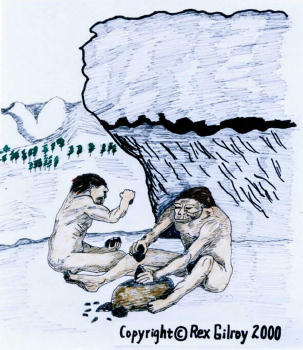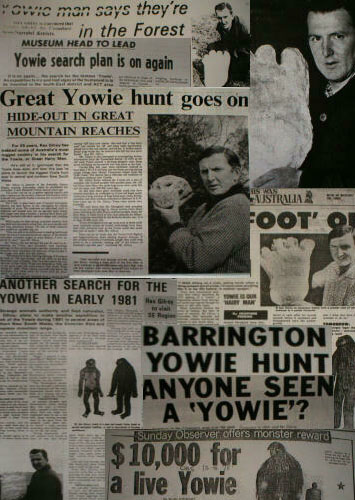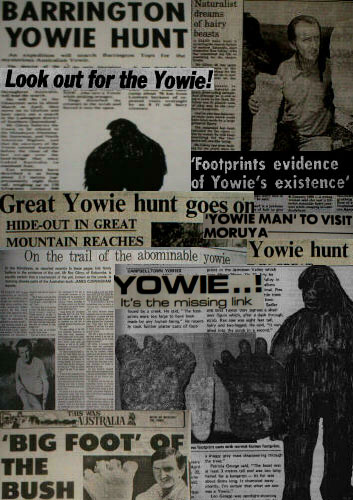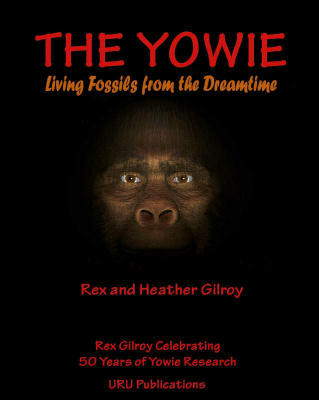A Short History of Early “Hairy Man” Reports
This article is composed of extracts from the 2007 book:
“The Yowie Mystery - Living Fossils From The Dreamtime".Copyright (c) 2007 Rex Gilroy, Uru Publications.
There has over the years been a growing library of books on the subject of overseas ‘relict hominids’ believed to survive in modern times in the remote and little explored corners of the world. The Yeti, or ‘dweller among the rocks’ of Himalayan folklore, and the Sasquatch, or ‘Bigfoot’ of North American Indian tradition are best known. Less well known are primitive hominid forms believed to inhabit places such as the African Congo, the jungles of South America, Russia, China, India, parts of island south-east Asia, New Guinea, island Melanesia, New Zealand and Australia.
Indeed, until I Rex Gilroy, was able to first publicise the ‘hairy man’, in the Australian and then world-wide media, few people even within this country had ever heard the name ‘Yowie’.
Our book “Giants from the Dreamtime – the Yowie in Myth and Reality” [URU Publications 2001] the first book ever written on the mystery, certainly changed that and has become THE text book for sensible field researchers. Now “The Yowie – Living Fossils from the Dreamtime” [URU Publications] goes much further, in a scientific manner as before in language that the lay reader can easily understand [which is how we prepare all our books], to present a startling array of evidence, to reveal the Yowie and its origins.
This book is needed, because since the publication of “Giants from the Dreamtime” much new fossil and other evidence has been uncovered, which has added further to our knowledge. It will leave little doubt that the Yowie is a flesh-and-blood, living ‘relict hominid’, a survivor of Ice-Age times which, in the form of Homo erectus, is our immediate ancestor. ‘He’ is our ‘father’ and as such deserves far better respect than ‘he’ has been given over the years, not only by an ignorant media, but also by those ill-informed and un-trained “Yowie catchers” who treat him as nothing more than a hairy monster!
Ancient Aboriginal myth and legend has always described the “hairy people” as flesh and blood hominids, and much the same picture is formed in the relict hominid folklores of the Polynesian and Melanesian people outside Australia, as well as those of south-east and mainland Asia. European knowledge of the “hairy men and women” of the Great South Land can be said to have really begun with the arrival of the First Fleet in Sydney Cove in 1788.
There is an account, which reached London in a letter in 1820 which told of an encounter in 1789 by several convicts and a party of marines, with a “great hairy man like beaste” while on a hunting trip. The men had ’bagged’ a few wallabies and were returning to the settlement when, atop a nearby hillside, they saw the hominid observing them from among trees. The mariners agreed the ‘animal’ was twice the height of an ordinary man. They fired their muskets at him, but he eluded them among the trees.
The First Fleeters who befriended the Aboriginal inhabitants of Sydney Cove, soon learnt of the monsters known as ‘Yowee’ and ‘Yahoo’ that inhabited the surrounding forest land. The tribesmen called a nearby bay ‘Yowee’, because of the numbers of “hairy men and women” who roamed its shores; and it was in the vicinity of what is still today ‘Yowie Bay’ [Miranda district] that, around January 1795 another hunting party of soldiers and convicts are claimed to have spotted a man-sized ‘thing’ running from them over a tree-covered ridge overlooking the bay. Photograph right: Aboriginal Girl wearing a Kangaroo hide Garment. Photographer Unknown. I will credit anyone who owns this photograph.
In the book ‘Modern Geography – a Description of the Empires, Kingdoms, States and Colonies: with the Oceans, Seas and Isles: In all Parts of the World’ by John Pinkerton, published in 1804, there is the following comment concerning a strange population of ‘Aborigines’ who shared the foreshores of Sydney Harbour with other tribespeople.
These ‘Aborigines’ were described as being flat-nosed with wide nostrils; thick projecting eyebrows with deeply sunk eyes. Their mouths were of ‘prodigious width’ with thick lips, teeth that were wide and even, with prominent jaws. They were described as being “remarkably hairy” [alluding to the kangaroo hide cloaks they wore]. They made fire, lived in rock shelters and used crude stone tools according to other observers of the time. The Aborigines of the harbour foreshores regarded them as another people entirely – the Yahoos or Yowies – the “hairy people”.
Further to the west of the Sydney district lie the rugged, vast Blue Mountains, where one can find a host of early settler’s tales. These are recorded at greater length in “Giants from the Dreamtime”. In the early 1900s some Blue Mountains residents could still recall the sketchy tale concerning a soldier of Governor Macquarie’s regiment, who one day in or about 1820, went hunting somewhere near where the town of Springwood is now situated, and came face-to-face with a man-sized, ape-like ‘animal’, that approached him from out of trees, making threatening gestures at him, whereupon the soldier raised his musket and shot the creature dead.
In the wake of Blaxland, Lawson and Wentworth’s 1813 crossing of the Blue Mountains, European settlement soon followed their route into the western plains beyond. Barrallier’s route was never developed as the terrain was considered to be too difficult for road construction. Farmers also moved in from the Hunter Valley to colonise the northern fringes of what is now the Wollemi National Park north of the Blue Mountains. It was hereabouts in 1819 that one family claimed to have been visited by a “hairy man” on their Newnes Plateau property. The man-sized creature was claimed to have walked up to the family’s bark hut, peered inquisitively through a window, then after alarming the people inside, dashed off into the scrub.
In what is now Kandos Weir in the Pagoda Rocks country, in 1820 a 7 ft tall female creature, clad in a marsupial hide garment, was claimed to have emerged from scrub to snatch 7-year old Adam Firth from a creek bank near his family’s farmhouse while he was playing and carried him off back into the scrub. According to Adam later, she kept him in a large rock overhang for a time, and tried to get him to eat a leg of kangaroo she had left on a smouldering fire, in what was apparently her camp. Others of her kind were nearby because Adam said that he heard sounds of them in the bush.The cries of his family and cattle dogs alerted the female hominid and she suddenly bolted for the scrub and with the rest of her kind vanished into the gullies as Adam began calling out to his parents.Tales from the Blue Mountains are many and can be found in our book “Giants from the Dreamtime – The Yowie in Myth and Reality”.
Similar tales were being told by settlers of Queensland’s far north in the 1860s. For example, in the Atherton district in 1871, cattlemen and timber cutters reported the finding of footprints of enormous length and width. Down on the coast at Cooktown, settlers and gold prospectors between 1868 and 1871 claimed to have seen both male and female human-like beasts of prodigious height in the mountain jungles inland from Cooktown settlement.
Further south into New South Wales, deep in the Bellbrook-Carrai Range, there are still old tales of encounters with “hairy giants” that date back to 1840-1852. It was in 1852 that a Bellbrook farmer, a Mr Jefferson, saw “an 8 feet tall, very ugly naked female beast” and fired his rifle at her, scaring her away from the edge of his property. Earlier, in 1840, two young boys while playing on a track near their Daisy Plains [Carrai] farm almost ran into a “big man”. Their parents refused to believe that the ‘man’ was the 12ft height that they intimated to them. However, the boys’ claim was vindicated some days later, when their father cam across “monstrous foot marks” in creek bank mud, and another family in the area claimed to have seen such a giant.
The mountains behind Taree, further down the coast, were not safe to enter unarmed in the 1840s. In 1841 a “12 foot height giant man” was claimed seen thereabouts by several settlers; and local Aborigines warned people that there were whole families of these giants living up in the mountain wilds.
Further inland, the Barrington Tops-Mt Royal Range region was a prolific area for “hairy man” accounts, both giant-size and otherwise during the 1840s and there are still vague tales among locals of sightings and close encounters with “the Beast-Men of the Barrington”, dating back to 1837, when a number of men from the foot of the range found “monstrous man-feet” in forest soil, freshly made and leading up a gully. Following these tracks the party caught sight of a monstrous male hominid, clad in a cloak of marsupial hide, a good 12 feet in height, they all agreed afterwards. The huge male was carrying a large tree limb club as he stood atop a cliff about 100 yards ahead of the men, observing their approach. However, at the sight of the man-giant the party lost little time in retreating in a panic!
In the Denman district of the Hunter Valley to the south of this range and near Muswellbrook, sheep and cows went missing over the years on a regular basis, during the 1830s and 1840s. They were taken, it was believed, by local Aborigines. Yet when questioned the Aborigines claimed that “giant hairy men” were responsible! They warned the Europeans that these beings stood anywhere from 12 to 14 even 15 feet tall! South of Denman is the vastness of today’s Wollemi National Park and it is likely that, whatever the true height of the “giant hairy men” they probably originated from there.
On the western side of the Wollemi lies Glen Davis and Newnes. This is a region well steeped in “hairy man” tales from way back. One old tale of the shale miners who worked in these valleys generations ago, concerned a Mr Charles Wilson, who in 1893 went missing in the Glen Davis scrub. What was left of his cannibalised body was discovered by people a day or so after his disappearance. The local belief was that he had fallen victim to the “Giant Hairy Man” – actually ‘men’ – believed to roam those wild valleys.
Aborigines called them the Jogungs, saying that they inhabited the whole of the Blue Mountains. Much later, in 1950 in the Kanangra wilderness timber cutters, came upon huge, freshly-made footprints of more than one of these huge beings, which a tape measure showed were a metre in length. The discovery revived old tales among people of the nearby Oberon district, of the “giant men and women” that prospectors and others in the mid-19th century, had believed inhabited the Kanangra-Burragorang forests. The many huge stone implements turning up in those wilds today gives credence to these old bushmen’s yarns.
Southern New South Wales, particularly the south coast and adjacent mountain ranges, possess their own share of “Giant Hairy Man”/Rexbeast folklore. For example, there was the “Giant Woman of the Deua River”, who back in 1918 caused something of a stir among the locals.This animal hide clad female, reputed to have stood around 9ft in height, was in one instance claimed seen by a picnicking family at one Deua River location and this was enough to dissuade other picnickers from frequenting the area for some time. Similarly, a ‘14ft tall giant”, a male, was claimed seen by more than one farming family in the Tuross River district inland from Narooma, on and off over a lengthy period, between 1925 and 1936. Even allowing for an exaggerated couple of feet, these locals had to have seen something that was enough to terrorise them all.
There is in fact, much credence given to these giant hominids.In December 2003 a 2.8m tall hairy male being, clothed in kangaroo hides, was seen by an elderly couple as he lurked among trees near the Brown Mountain Lookout, which overlooks the coastal flats on the way to Bega. The area forms part of the Bemboka National Park, which contains 16,500ha of high peaks, ridges and escarpment country. The Lookout overlooks Bemboka Valley below. Tales of large, animal hide cloaked, stone or wooden tool carrying hominids – males, even females and their young – seen in the Bemboka Valley date back to the 1840s.
For thousands of years the Bemboka Valley provided a ready access route for Aborigines moving between the coast and Monaro Tableland country. Even then the tribespeople trod warily through those forests, for fear of meeting up with the hairy giants they believed roamed those wilds. European settlement in the valley began in the 1840s, when the Imlay brothers established a cattle station east of the current Bemboka village.
It was in 1840 that an Aboriginal workman at Bemboka fell prey to a “hairy giant”. His body was found nearby a creek, his head smashed by a large rock. Nearby huge footprints in sand told the discoverers of his body what had happened. About that time a 3m tall manbeast was claimed seen by settlers roaming the bush, armed with a big stone club, outside Bemboka Township, while others sometimes claimed to see more than one female and child in the scrub thereabouts.
By the 1870s the advance of civilisation saw attempts made to open up a suitable road access route westwards out of the valley. The Snowy Mountains Highway following this route was finally opened in 1889, Workers on the highway that year claimed to have found large, man-like footprints in soil along the road, and also in nearby scrub in one area. The “Hairy Giants of Bemboka” came into prominence about 1844, when a bark hut was reported to have been totally demolished by “several hairy monstrous men of great height”, as Charles Jameson, the owner claimed. Local farmers armed with guns set off in search of the assailants, but no trace of them was found, other than the giant footprints around the wrecked hut.
“The Yowie Mystery - Living Fossils From The Dreamtime".
“The Yowie Mystery - Living Fossils From The Dreamtime". Special Dedication. The Authors dedicate this book to the late Charles Melbourne Ward F.Z.S.; F.R.Z.S. known to his great many friends simply as ‘Mel’. Together with his wife Halley, he operated a natural history museum in the grounds of the Hydro Majestic Hotel at Medlow Bath for many years and also another established at Echo Point, Katoomba. It was ‘Mel’ who first taught me how to collect, record and study natural history specimens, beginning when I was aged 11 years old on holidays with my parents at Katoomba in 1954. Thereafter, every school holidays spent in Katoomba began with a visit to ‘Mel’ at his Medlow Bath Museum to inform him how my fledgling natural science studies were progressing!
As a result and after my parents moved from our Lansvale [western Sydney] home to Katoomba, the Gilroys and Wards became close friends. There was hardly a week which did not see me peddling my pushbike from our North Katoomba home up the Great Western Highway to see ‘Mel’ at his museum for more instruction. Mel Ward possessed a wide knowledge of the culture of the Australian Aborigines and that of the former local Blue Mountains tribes in particular.
He was also a firm believer in the “Hairy Man” and supported my researches in this regard. At my 21st birthday party, held at the Homesdale Function Centre, at Katoomba on Saturday night 8th November 1964, I well recall how my old friend, in front of a large gathering, congratulated me on my researches and the large natural science collection that I was forming and then said: “You’ve done a fantastic job Rex, BUT IT’S ABOUT TIME THAT YOU STARTED MAKING SOME BLOODY MONEY OUT OF IT” in a loud voice that brought the house down!
That following week, together with my father Mr W.F. [Bill] Gilroy, I began a search of local venues, which soon resulted in the acquisition of the lease from the Blue Mountains City Council of the Mt York Tea Rooms, outside Mt Victoria, the rest they as “is history”. Two years late, on October 6th 1966, Mel Ward was dead, having passed away in his sleep. He once said to my father that I was “the Mel Ward of Tomorrow” and I am certain that Mel would be pleased to know that I have indeed followed in his footsteps.
Mel led an adventurous life. The son of Hugh J. Ward, a famous Shakespearean actor of the early 20th century, Mel was encouraged to go on the stage by his father but Mel developed a passion for the natural sciences and his wealthy parents helped him become established. In his lifetime of achievement, Mel became recognised as a world authority on Crustaceans and an anthropologist. He was made a Fellow of the Royal Zoological Society of New South Wales and was pleased when I too became a member of the Society in 1963. He encouraged me, not long before his death, to take on the Presidency of the Society’s Entomological section, where I served for three years from 1966 to 1969.
That he achieved so many things in the course of his lifetime researches is remarkable, because like this author, he was an amateur with not one university degree to his name! I am certain that my old friend would be delighted at the fact that, together with heather, I am now writing and publishing book on the subjects he loved and on the Yowie in particular. He taught me never to blindly follow the textbook and dare to question dogmas and not be told what to think! I have certainly followed his advice. Knowing Mel Ward as I did I know he would wholeheartedly approve of the scientific approach of this book, therefore “Mel”
This Book is for You!
Rex Gilroy - Australian Yowie Research Centre, Katoomba, NSW.
Monday 25th June 2007I also present sensible advice to any future would-be Yowie investigators. The reader will also be awed at the great many discoveries my wife Heather and I have made in all our years together in the field. I feel privileged to be the founder of Yowie research and to have encouraged other, sensible researchers to follow my example. The search for surviving relict hominids in remote, hidden regions of the world, has been called the “last great search”, and it is both a fascinating and exciting one. Rex Gilroy may be contacted at the Australalian Yowie Research Centre, PO Box 202, Katoomba. NSW 2780. Ph 02 4782 3441 or email New Email Address as of June 2009 randhgilroy44@bigpond.com on or visit our website : http://www.mysteriousaustralia.com/ or http://www.australianyowieresearchcentre.com/ or http://www.rexgilroy.com/
Newspaper Articles on Rex Gilroy's Lifetime Search for the Australian Yowie
Newspaper Articles on Rex Gilroy's Lifetime Search for the Australian Yowie
Aboriginal/Koori Names for the Australian Yowie
To present the Yowie mystery in its proper context, relict hominid evidence from south-east Asia, New Guinea, other west Pacific Islands and New Zealand is revealed, demonstrating how the ancestors of these ‘manimals’ once spread out across the earth via land-bridges that formerly joined Australia/New Guinea/New Zealand with what is now island south-east Asia to the Asian mainland.
“Hairy man” was a name given by the Aborigines to any non-Aboriginal race with which they shared this continent, but the term centred primarily upon at least three basic forms. These forms were either the height of an average human being, an enormous man-like and also ape-like form. All were known by different names Australia-wide, but all meant either “hairy man” or “great hairy man”.






